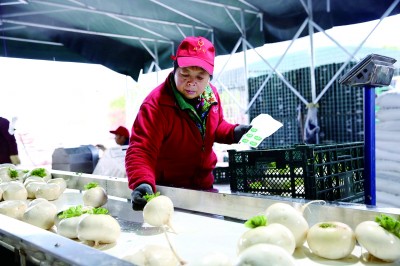
A bird’s-eye view of the agricultural production base that now exists in Shuangfeng village, Ganshui town, Qijiang district, Chongqing municipality, in southwest China. [Photo by Zhan Jiangtao / Guangming Online]
What was once abandoned wasteland in Shuangfeng village, Ganshui town, Qijiang district, Chongqing municipality, in southwest China, is now a thriving agricultural hub. In the summer of 2024, resident Li Jianqun was busily tending to his watermelon crops near ponds full of lush lotus flowers in full bloom and fields of thriving sweet potatoes intercropped between rows of recently harvested waxy corn under the warm sun and clear blue skies.
“Watermelons sell best in the heat,” he shared, adding that the village’s vitalized economy has enabled him to earn a steady income where he was born. “I used to work elsewhere, but now I can stay with my family while making a living.”
Overcoming obstacles to prosperity
Located between 350 and 1,080 m above sea level, Shuangfeng is a typical rural mountainous Chinese community. In the past, its residents struggled with issues such as poor transportation, limited water resources and fragmented land. Farming was unreliable, and the lack of strong industries in the local area forced many of the people who were born there to seek work elsewhere, which resulted in large portions of farmland being abandoned.
A turning point came in early 2022, when Lin Hao, the newly appointed Party secretary of Shuangfeng, took office and saw an opportunity in the vast stretches of unused land that existed within its borders.
“We needed to make use of idle land resources and boost the collective village economy through agriculture,” the official stated, recounting the ambitious plan to reclaim the wasteland that he had developed.
The task was daunting, however. Shuangfeng’s abandoned land was overrun with waist-high thatch and thick thorn bushes. Furthermore, the village did not have any funding available that it could use to start the project with, and even local Party members were skeptical of Lin’s bold idea.
Undeterred, he took a big risk. Without informing his family, Lin secured a RMB400,000 (US$56,080) loan in order to jumpstart the project, using personal assets as collateral.
“I was one of the main opponents at the beginning,” admitted Liu Yong, the village’s deputy Party secretary. “But Lin’s determination inspired us all.”
Shuangfeng held a series of meetings in order to facilitate discussion and attain a consensus, with the support of village leaders. Eventually, residents agreed to lease 60 ha of abandoned land to Shuangfeng’s collective at the rate of RMB3,000 (US$420) per ha per year. Excavators arrived that August, and the village was abuzz with activity.
Roads were built, ponds were dug, and the landscape was reshaped. In just a year, the abandoned land that existed was transformed into fertile fields, and the village’s infrastructure was improved.
Shuangfeng’s signature crop, the Caodou radish, is renowned throughout China for its tender skin and juicy, delicious flavor. Similarly, the village’s waxy corn is beloved for its sweet flavor, soft consistency and rich nutrient content. Shuangfeng has created a thriving year-round agricultural economy by growing corn and watermelons during the first half of the year and radishes in the second half. Orders for its produce now flood in from nearby cities and generated over RMB2.3 million (US$322,460) of revenue in the first year alone.
Integrating animal husbandry with fertilizer production
Shuangfeng’s crops flourished, but its residents did not stop there. They established a pig farm at the highest point in the village, and a digital farming model was implemented. Customers can adopt pigs and monitor their growth in real time with their smartphones. The innovative approach has further stimulated the local economy.
Resident Li Yi, a skilled pig farmer, reflected on how the development that Shuangfeng has experienced in recent years has transformed his life.
“In the past, the high transportation costs and limited resources that existed made pig farming difficult,” he noted. “Now, with the village collective supporting us, I can expand my farm without worrying about sales.”
Li mentioned that he was currently generating more than RMB150,000 (US$21,030) of revenue per year from pig farming alone.
Crop cultivation requires fertilizer, but excessive use of chemical fertilizers can lead to soil compaction and reduced fertility, ultimately outweighing any benefits. Shuangfeng thus adopted an eco-friendly approach. Pig manure is fermented into fertilizer and, utilizing the natural slope of the land, is piped down to lower-lying fields. The crops that are grown, in turn, provide natural feed for the pigs, creating a virtuous cycle involving crops and livestock.

A worker selects radishes in Shuangfeng. [Photo by Zhang Menghan / Guangming Online]
Adding value via processing and pursuing agritourism
Shuangfeng’s residents built a processing factory capable of producing dried radish products at the foot of the mountains as the village’s agricultural output grew, which increases the output value of each metric ton of the crop by more than RMB500 (US$70). Lin emphasized that the factory addresses seasonal market saturation, ensuring that the radishes that are grown command good prices year round, in addition to providing jobs for local residents.
In 2023, per capita income in Shuangfeng surpassed RMB14,000 (US$1,962), a significant increase from previous years. The village has also been pursuing agritourism in recent years in order to promote beautification and further prosperity.